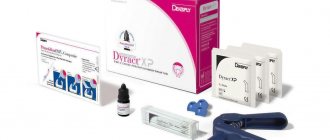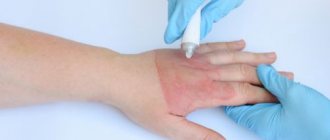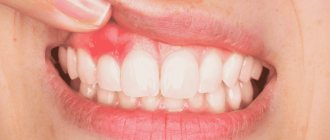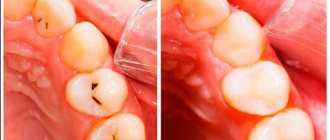26.11.2019
Today, there are often situations when, after dental treatment, a filling interferes with the patient. Although during the process of filling and correction the dentist carries out all the necessary manipulations so that the material does not seem like a foreign body, it is not always possible to do everything perfectly. The problem is fraught with impaired chewing function and improper closing of the jaws. You should study in detail the symptoms and causes of this phenomenon, and also figure out how the patient should behave in such cases.
Symptoms of an incorrectly placed filling
Very often, patient complaints about discomfort after installing a filling have nothing to do with improper manipulation or excess materials. This often happens when most of the tooth has been destroyed and the patient has become accustomed to the emptiness. Consequently, after filling, a false feeling of discomfort appears, which is caused by an unusual feeling of fullness in a place that has been empty for a long time. In such situations, you need to wait a little - often within a few days a person gets used to the new sensations, and the installed filling ceases to cause discomfort.
First of all, you need to figure out how to understand whether the discomfort is associated with the adaptation period, or whether the unpleasant sensations are a consequence of the doctor’s incorrect actions.
There are several symptoms indicating improper installation of filling material:
- On the side of the tongue, in the place where the product is installed, pain is felt or there is a wound.
- During chewing, discomfort is replaced by a feeling of pressure or pain.
- After a visit to the doctor, the patient experiences articulation disorders - slurred pronunciation of sounds.
- When you try to compress your jaws, the presence of foreign material prevents you from doing so.
If at least one of the above-described signs appears, we can say that the structure requires additional polishing.
Types of overbite fillings
Two types of structures are most widely used in orthodontics:
- Katz model. The filling is held on the chewing teeth using loops and grips.
- Model of Khurgina. The design has a rubber traction.
The materials from which the platforms are made must be reliable, since the product is subjected to significant loads. Most often used:
- artificial dentin;
- dentin paste;
- cement;
- polymers.
Many orthodontists prefer the latter option. When dental polymers harden, they do not turn into stone, but acquire a fairly elastic consistency, similar to rubber. Polymer fillings adhere well to enamel and do not require additional processing.
Causes
The main reason for the appearance of the symptoms described above is an excess of filling materials and inaccurate formation of the surface of the restored unit. Because of this, the surface of the tooth becomes slightly higher than necessary for proper closure of the jaws.
The qualifications of the specialist who performed the filling procedure are not always the cause of the problem. Often, local anesthesia is used during the installation of fillings, so the patient may not accurately describe his sensations when the specialist asks him to describe the sensations after the final polishing is completed. As a result, after the medication wears off, discomfort appears that was absent when you were in the dentist’s chair.
In some cases, the source of discomfort may be the inflammatory process of the periodontium, due to a violation of the stable position of the dental unit. Almost imperceptible tooth mobility can disable the mechanism of closure of the upper and lower jaw. But before the filling was carried out, the missing part of the unit compensated for the defect. Accordingly, after complete restoration of the size and shape of the tooth, the disease manifests itself in full.
Another cause of discomfort can be tooth misalignment. Often this symptom appears after filling a gap between teeth or removing a unit in the same row. Complaints that the filling is in the way appear several months after installation. The missing unit causes the remaining teeth to shift towards the empty space, so when they are closed tightly, unpleasant sensations appear.
A common cause can also be an excessively thin wall between the pulp chamber and the product. Because of this, the pressure that is applied to the filling during chewing is transferred to the bottom of the chamber and irritates the dental nerve. In such cases, the cause of the unpleasant sensations lies inside the dental unit, but is felt as a structural defect.
Content
- Causes of destruction
- Activities before treatment with a doctor
- Temporary filling fell out
- A permanent filling fell out
- Price
- Prevention of destruction
No one is safe from falling out or partial chipping of a filling. The patient experiences discomfort. This is both a moral component and very real inconvenience. The problem becomes the inability to chew food normally, excessive tooth sensitivity, even pain. You need to contact a specialist immediately to stop tooth decay and restore its normal functions.
PROMOTION
Dental restoration, installation of fillings
from 2200 rub.
Norm or pathology
Let's consider the options for normal and pathological conditions, in which you should immediately consult a dentist.
Is it worth going to the doctor?
It is unlikely that you will be able to correct the situation on your own without qualified help. Therefore, if the filling interferes, you need to contact your dentist.
Many people, when faced with such a problem, try not to pay attention and wait for the material to erase itself. This opinion is erroneous, since modern dental preparations used for filling have high strength values. Therefore, it can take years for abrasion to occur.
The opinion regarding shrinkage over time is correct, but until this happens, a significant period of time may pass. It is impossible to get used to unpleasant symptoms, and keeping the jaw in this state for a long time can lead to negative consequences.
What to do if a permanent filling falls out
When a filling falls out, there is a real risk of infection and the development of recurrent caries. Another problem is tooth decay, since the walls of the cavity receive excessive force. The tooth will inevitably begin to decay. Therefore, visiting a specialist as soon as possible is the only correct option in such a situation. The patient can avoid the negative consequences of a filling falling out in several ways:
- Do not put any stress on the affected tooth.
- Avoid aggressive influences - sour, sweet, salty, hot and cold.
- Ensure thorough hygiene, remove food debris and plaque.
- Rinse the tooth.
- Make an appointment for a follow-up appointment immediately.
Home treatment methods
As mentioned above, it is impossible to get rid of the problem at home, and it is unreasonable to expect natural abrasion of the material.
To alleviate the condition before visiting a specialist, you need to follow certain recommendations:
- Avoid eating hard foods that require biting. The sealed unit, due to its higher location, is subject to the main load, and this is fraught with a fracture of its base.
- Eliminate hot foods from your diet. This is because such foods and drinks can cause swelling of the soft tissues, increasing the discomfort.
- For severe pain, analgesics or non-steroidal anti-inflammatory drugs can be used. However, you should not abuse such drugs, because their use is limited - no more than 5 days.
How does tooth filling occur?
The choice of material for closing a carious cavity depends on the individual characteristics of the patient and other factors. In modern dentistry, photocomposites are most often used. Reflective materials are reliable, have a long service life and allow you to completely restore a tooth damaged by caries.
At the initial stage of treatment, the doctor cleans the cavity of dead tissue and bacteria. Then the working area is treated with a special solution. To avoid moisture ingress, the tooth to be restored is isolated with a latex scarf. If this process is disrupted, the integrity of the restoration will suffer and the filling will be installed poorly. Over time, this can lead to recurrent tooth decay.
After processing, a bond is fixed to create an adhesive layer that increases the reliability of fixation of the material on the tooth tissue. A flowable composite is then applied to the cavity walls and hardened using a curing lamp. The material is applied in layers. Each portion is exposed to a lamp.
At the last stage of treatment, the final fitting, grinding and polishing of the filling takes place. This is necessary to give the original shape and form the correct bite.
What will the dentist do?
First of all, the doctor will perform repeated manipulations to process the product using a copy napkin. After applying it to the tooth, the patient will need to clench his jaw tightly. The interfering area is determined by the imprints left on the surface of the unit.
If the cause of the pain is periodontal disease, a periodontist is involved in the treatment process, who, together with the therapist, works to eliminate the problem.
In some cases, removal of the filling may be indicated. After preparing the dental unit, medicinal substances are placed in it, as well as an insulating lining. Then a temporary filling is installed and the patient is sent home. If after a second visit the dentist notices an improvement, a permanent product is installed.
Result of use
The use of platforms accelerates the achievement of set goals for occlusion correction. Simultaneously with the elimination of aesthetic imperfections in the smile area, the functioning of other organs and systems of the body that suffer in patients with pathological occlusion is normalized. This:
- the digestive system, the functioning of which is determined by the quality of grinding food in the oral cavity;
- overstrain of the neck muscles, which occurs as a result of excessive load on the masticatory muscles, a shift in the center of gravity of the head with asymmetrical development of the jaws;
- pathological changes in the temporomandibular joint;
- periodontal diseases that develop as a result of excessive load on the tissue;
- persistent headaches.
To eliminate the violations identified in the patient, bite pads of various types can be used. The choice of the most suitable option is carried out taking into account the type of occlusion, the condition of the teeth, the degree of discrepancy in the size of the jaws, and the condition of the gums.
Possible consequences
If the installed filling material interferes with the full closing of the mouth and jaw closure, this is fraught with side effects for the patient.
The consequences may be as follows:
- Pressure on antagonist teeth. If the product is not installed correctly, the adjacent teeth will exert constant pressure on the filled unit. It can provoke periodontal trauma and the development of secondary caries.
- Formation of cracks and chips on the surface. Excessive pressure can not only cause injury, but also lead to chipping. In addition, weak tooth walls can break off along with the filling.
- Dislocation of the jaw. Incorrectly installed elements can cause insufficient jaw closure. Misalignment of one part in relation to the other will lead to dislocation.
Design features
The design and appearance of bite platforms are varied. For the most part, they have several components:
- the platform itself, which is located between the teeth and prevents them from completely closing;
- metal hooks or clasps with which the device is held in the oral cavity;
- labial arc, which combines the platform and hooks into one whole.
Instead of clasps, rubber rods or special rings can be used to hold the labial arch on large molars.
Expert advice
The arrangement of teeth in a row was initially determined by nature, so the elements must touch correctly for the full implementation of the chewing function. A change in the bite can cause an incorrect distance between the jaws. Once such a pathology develops, it will be much more difficult for the doctor to eliminate it.
To minimize the likelihood of complications, the patient must take certain actions himself. If bite defects are observed within a few days after installing the composition, you should immediately consult a dentist. Correcting the filling will take a few minutes, but these manipulations will help prevent the development of disorders.
After installing the material, some people complain about roughness and stepped placement of the composition. Pathogenic microorganisms can accumulate in the formed cavities, which will lead to the development of secondary caries. In such cases, it is also necessary to urgently visit the dentist's office.
Category Dental filling Posted by Mister stomatolog
Rules of care
Removable pads must be stored in a special solution and washed in water before putting them on. A disinfectant solution is necessary in order to reduce the number of microorganisms on the surface of the structure and avoid the appearance of bad breath. The fixed platform must be cleaned of plaque twice a day with a special paste and a soft-bristled brush. When playing sports, it is better to leave removable structures in the locker room.
How long can a filling last?
The service life depends on the selected dental treatment material. The photopolymer composite is well fixed and wears minimally. If all rules are followed during the filling stages, as well as proper oral hygiene, fillings will last about 10 years or longer. Please note that the operation of any material is poorly affected by mechanical loads. For example, it is strictly not recommended to open lids with your teeth or chew nuts or seeds.
Attention. Proper hygiene includes not only home care, but also regular professional cleaning. The dentist will select the procedure method taking into account the individual needs and characteristics of the patient.










